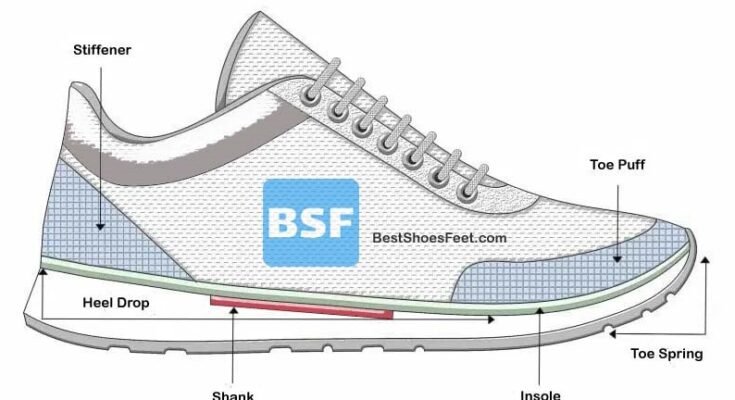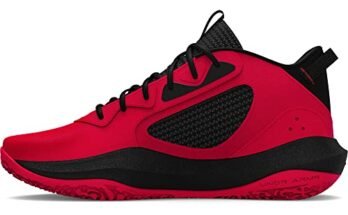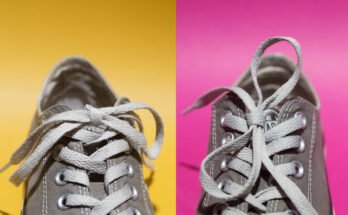Shoe Anatomy
The anatomy of a shoe can be quite complex, with many different parts and components that work together to provide support, comfort, and style. Some common terms used in the industry include the upper, which is the part of the shoe that wraps around your foot; the outsole, which provides traction and protection; and various cushioning layers that help absorb shock as you walk or run. Other important parts of a shoe include the heel counter and toe box, which provide stability and support for your feet during movement.

Whether you’re looking for running shoes or dress shoes, it’s important to understand all of these different components so that you can choose a pair that best meets your needs. With so many options available today, it can be difficult to know which features are most important and how they work together to make a shoe comfortable, supportive, and stylish. But with a little research and guidance from experts in the industry, you can find the perfect shoe for your needs that will keep you moving comfortably and looking great!
Shoe Terminology
Ever wondered how your favorite pair of shoes is put together? The anatomy of a shoe can be quite complex, with many different parts and components that work together to create the perfect fit and support. At its most basic level, however, a shoe can be divided into three main components: the upper, which is the part of the shoe that wraps around your foot; the outsole, which provides traction and protection; and various cushioning layers that help absorb shock.


Outside Parts of the Shoe
When it comes to the anatomy of a shoe, there are many different parts and components that work together to provide support, comfort, and style. Some of the most important outside parts of a shoe include the upper, which wraps around your foot; the outsole, which provides traction and protection; and various cushioning layers that help absorb shock as you walk or run. Other important parts of a shoe include the heel counter and toe box, which provide stability and support for your feet during movement.
Whether you’re looking for running shoes or dress shoes, it’s important to understand all of these different components so that you can choose a pair that best meets your needs.
The following is a list of terms used to describe the outside parts of the shoe.
Heel counter: The heel counter is a hard plastic or metal component that wraps around the back of the shoe, providing stability for your foot as you move. It helps prevent your ankle from rolling too far inward or outward and supports the shape of the shoe.
Backstay: The backstay is the part of the shoe that runs along the Achilles tendon in your heel and provides additional support for this area. It may be made from a variety of materials, including leather and synthetic suede, and can help prevent your feet from sliding too far forward in your shoes.
Breast: The breast is the part of the shoe that covers and protects your toes. This area can be made from a variety of materials depending on the type of shoe, but typically provides protection and comfort for your toes as you move.
Counter: The counter is a stiff strip of material attached to the upper on the inside back edge of the shoe. It is there to help support and stabilize the heel area, thus preventing it from collapsing when you wear them.
Collar: The collar is the soft band of material around the shoe’s opening that helps hold your foot in place. It may be made from a variety of materials and can offer additional support for your feet as you move.
Eyestay: The eyestay is the part of the shoe that holds the laces and helps keep it secure to your foot. It may be made from leather, fabric, or synthetic material and can offer additional support for your feet as you move.
Quarter: The quarter is a term used to describe the back portion of a shoe just below where the lacing area ends. It is also known as the “heel counter” and can come in many different materials, such as leather and synthetic suede.
Eyelet: An eyelet is a small metal, plastic or fabric loop used to secure the shoe onto your foot. Most shoes have several eyelets that help keep your laces in place as you move.
Feather edge: The feather edge is a term used to describe the seam on the back of the shoe just above where it ties around your foot. It may be made from leather or other material and can help provide additional stability for your shoe as you walk or run.
Heel: The heel is the back part of the shoe that rests on the ground as you walk or run. It may be made from synthetic materials, such as plastic and rubber, or leather. The length, shape and design can vary depending on what type of shoe you are using.
Heel seat: The heel seat is a material that runs along the inside part of the shoe’s heel, helping to keep your foot stable as you move. It may be made from leather or synthetic suede and can help prevent your feet from sliding too far forward in your shoes.
Sole: The sole is the bottom part of the shoe that makes contact with the ground as you walk or run and offers traction for your feet. It may be made from plastic, rubber, or other materials designed to protect and cushion your feet as they move.
- Outsole: The outsole is the part of the shoe that comes into contact with the ground and provides traction for movement. It may be made from rubber, plastic, or other materials.
- Midsole: The midsole lies between the upper and outsole and consists of cushioning layers designed to absorb shock as you walk or run. These layers can be made from foam, gel, or other materials that provide softness and comfort as you move.
- Insole: The insole is the part of a shoe that comes into contact with your foot. It can be made from leather, fabric, or synthetic materials and can help support your feet as you move. There are many different types of shoes available to meet all of your needs, whether you’re walking around town, running errands, or out on.
Throat: The throat is the part of the shoe that surrounds and secures your feet as you move. It may be made from leather, fabric, or synthetic materials and can help keep your feet in place as you walk or run.
Toe cap: The toe cap is a material that covers the front part of your shoe to protect and cushion your toes as they move. It may be made from leather, plastic, or synthetic suede and can help prevent damage to your feet as you walk or run.
Toe box: The toe box is the front part of the shoe that covers and protects your toes. This area can be made from a variety of materials depending on the type of shoe, but typically provides protection and comfort for your toes as you move.
Top Piece: The top piece is a term used to describe the back portion of the shoe that comes into contact with your heel. It may be made from leather, fabric, or synthetic materials and can help keep your feet secure as you move.
Topline: The topline is a term used to describe the edge of the shoe on your foot. This area can be made from leather, fabric, or synthetic materials and can help prevent your feet from slipping out of your shoes as you walk or run.
Upper: The upper is the top portion of the shoe that surrounds your foot. The upper part of the shoe is typically made from leather, fabric, or synthetic material and forms a sort of “sock” that wraps around your foot. This material provides support and helps hold the shoe on your foot.
Vamp: The vamp is the part of the shoe that covers your toes and the top portion of your foot. It provides protection and comfort for your feet as you move.
Waist: The waist is the part of the shoe that comes into contact with your ankles and helps provide stability as you walk or run. It can help keep your feet in place as you move.
Welt: The welt is a term that describes the connection between the upper and outsole of the shoe. It helps support your feet as you move.
As you explore different shoes to find one that’s right for you, it’s important to understand these key components so that you can make an informed decision about which features are most important and how they work together to support and protect your flat feet.

Internal Parts of the Shoe
Shoes are composed of countless components, many of which help house a shoe’s most important component – the foot. Understanding shoe structure begins with knowing its internal components, such as the midsole, foam padding, and toe box.
The midsole provides cushioning and enhances stability in a shoe by absorbing shock from movement. Foam padding is often strategically placed to protect a foot from abrasive pressure points and to maintain shoe shape. The toe box can also be filled with foam or leather for added protection and comfort around the toes. Overall, these components come together to create a shoe that fit comfortably on your feet for all kinds of activities!

Collar padding: Collar padding is an important component that helps provide cushioning and comfort to the foot around the ankle. This padding can help protect the foot from abrasive pressure points, especially in tight-fitting shoes.
Filler: Shoe fillers are materials that help to maintain the shape and form of a shoe. They may be made of leather, foam, or other durable materials and may be strategically positioned inside a shoe for optimal protection and comfort. For example, filler is often placed in areas such as the toe box – where extra protection is required due to high levels of friction.
Insole: The insole is the interior portion of the shoe that physically touches and houses a person’s foot. In most shoes, the insole is made of soft padding and helps to absorb shock from movement, resulting in enhanced stability and comfort.
Lining: Lining materials lie on the inside surface of a shoe and vary in their composition and function. Generally, they are used to keep feet dry by absorbing perspiration. In addition, these materials may also be made from leather or fabric that can provide resistance against abrasive pressure points within the shoe.
Counter lining: The counter lining is a portion of the shoe that, as its name suggests, lines up against the heel. This lining helps to shape and support the foot in the back part of the shoe and may be made from different materials depending on whether they are designed for greater flexibility or more rigidity.
Tongue lining: The tongue lining is a component located inside the shoe that lines up against the foot’s top section, or “tongue.” This material can also be made of different materials to enhance foot comfort and absorb shock from movement.
Vamp Lining: The vamp lining is the internal lining of a shoe that lies at the top of the foot and above the tongue area. It serves as an absorbent layer which wicks away moisture from feet by absorbing perspiration resulting in dry and comfortable feet.
Puff: Created from a thin and compressed piece of foam, puff is often used as padding in the toe box of shoes to provide support, cushioning, and protection against abrasive pressure points.
Seat: The seat of a shoe is the portion that connects the heel to the sole and provides stability for the foot. It can also be filled with foam or other soft materials to provide additional cushioning and comfort for the wearer.
Shank: The shank of a shoe is a layer that connects the sole to the counter and helps to provide support for the foot. It can be made from various materials, including metal, leather, or plastic, depending on how much rigidity it needs to maintain.
Stiffener: A stiffener is a component that helps to maintain the shape of a shoe, particularly at areas such as the heel and ankle. They may be made from metal or plastic materials and can vary in their shape and rigidity depending on how much support they need to provide.
Tongue padding: The tongue of a shoe is the section that fills the gap between the top of the foot and the lacing. Tongue padding is often made from soft materials such as foam, which help to support and cushion the foot in this area.
Further Useful Terminology
When it comes to finding the perfect shoe, having a good understanding of shoe terminology can be immensely helpful. This is because shoe features and attributes can range from performance-based characteristics such as durability and ‘breathability’ to more aesthetic aspects such as colour, pattern, style and so on.
With this in mind, being aware of terms like toe box shape, eyelet construction and cushioning system can assist in selecting the shoe that best meets one’s needs. Additionally, understanding phrases like sole design or heel counter will aid you in picking the shoe with the features that best fit your taste. By mentally listing out what you need from a shoe before shopping it will be much easier to pick the right one when you come across it.
Gusseted tongue: A gusseted tongue is a tongue that has been sewn to the inside of the shoe, usually along its base. This type of construction helps to keep out dirt and moisture from the foot’s top section, particularly in those with more open-style lacing design.
Heel to toe drop: The heel to toe drop is the difference in height between the heel and toe of a shoe. Shoes that have a higher heel to toe drop tend to be more stable, while those with lower drops are typically designed for greater flexibility.
Kiltie: A kiltie is a shoe feature that consists of a fringed leather panel located at the tongue. This can be used to enhance your style or as an ornamental design, depending on the type and purpose of the shoe.
Medallion: A medallion is a decorative and functional component that is used to secure the laces of a shoe. It can be made from various materials, including metal, plastic or rubber, depending on how much traction it needs to provide in order to keep the laces securely fastened.
Perforations: Perforations are small holes that have been punched into the upper of a shoe in order to increase breathability and keep the foot cool and comfortable. These can be found in a wide range of materials, including leather, synthetic fabrics, and more.
Pinking: A pinking is a technique that uses zig-zag cuts in order to reduce the risk of fraying and unraveling on fabrics such as shoes. This can be done by hand, or through machines for more uniform and consistent results.
Penny keeper: A penny keeper is a slot that is commonly found on leather moccasins, which allows the wearer to store a coin or similar item in order to fasten the laces of the shoe.
Stack height: The stack height is the distance between the base of the heel and sole, when viewed from the side. This can vary depending on a number of factors, such as shoe construction or desired level of cushioning.
Toe spring: Toe spring is a vertical distance between the lowest point of the sole and an imaginary horizontal line that runs through the tip of the toe. A positive toe spring makes it easier to walk, as it helps push your foot down in front of you.
Tassel: A tassel is a small, decorative knot that is used to fasten up laces or the tongue of a shoe. This can be made from various materials, including leather, plastic and metal.
These internal components all work together to create a comfortable and supportive fit for your feet , regardless of the type of shoe you choose. So if you are looking for a new pair of shoes, be sure to do your research and understand what each component means in order to find one that is right for you.




